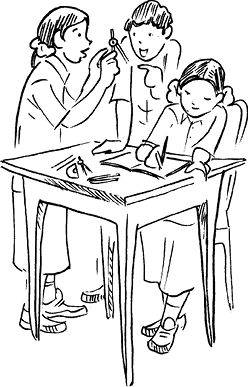Mathematics - Real Life | Maths 7th STd
Untitled
Chapter 15
Visualising Solid Shapes
15.1 Introduction: Plane Figures and Solid Shapes
In this chapter, you will classify figures you have seen in terms of what is known as dimension.
In our day to day life, we see several objects like books, balls, ice-cream cones etc., around us which have different shapes. One thing common about most of these objects is that they all have some length, breadth and height or depth.
That is, they all occupy space and have three dimensions.
Hence, they are called three dimensional shapes.
Do you remember some of the three dimensional shapes (i.e., solid shapes) we have seen in earlier classes?

Try to identify some objects shaped like each of these.
By a similar argument, we can say figures drawn on paper which have only length and breadth are called two dimensional (i.e., plane) figures. We have also seen some two dimensional figures in the earlier classes.
Match the 2 dimensional figures with the names (Fig 15.2):
(i)  (a) Circle
(a) Circle
(ii)  (b) Rectangle
(b) Rectangle
(iii) 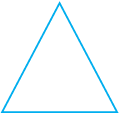 (c) Square
(c) Square
(iv)  (d) Quadrilateral
(d) Quadrilateral
(v)  (e) Triangle
(e) Triangle
Fig 15.2
Note: We can write 2-D in short for 2-dimension and 3-D in short for
3-dimension.
15.2 Faces, Edges and Vertices
Do you remember the Faces, Vertices and Edges of solid shapes, which you studied earlier? Here you see them for a cube:

The 8 corners of the cube are its vertices. The 12 line segments that form the skeleton of the cube are its edges. The 6 flat square surfaces that are the skin of the cube are its faces.
Complete the following table:

Can you see that, the two dimensional figures can be identified as the faces of the
three dimensional shapes? For example a cylinder  has two faces which are circles, and a pyramid, shaped like this
has two faces which are circles, and a pyramid, shaped like this  has triangles as its faces.
has triangles as its faces.
We will now try to see how some of these 3-D shapes can be visualised on a 2-D surface, that is, on paper.
In order to do this, we would like to get familiar with three dimensional objects closely. Let us try forming these objects by making what are called nets.
15.3 Nets for Building 3-D Shapes
Take a cardboard box. Cut the edges to lay the box flat. You have now a net for that box. A net is a sort of skeleton-outline in 2-D [Fig154 (i)], which, when folded [Fig154 (ii)], results in a 3-D shape [Fig154 (iii)].

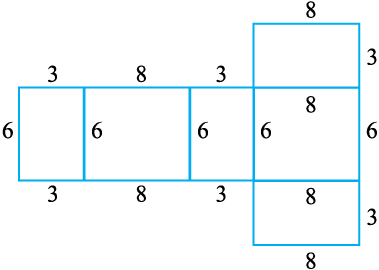
Similarly, you can get a net for a cone by cutting a slit along its slant surface (Fig 15.6).
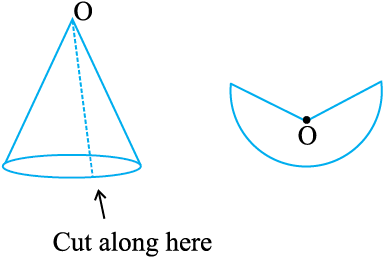
Fig 15.6
You have different nets for different shapes. Copy enlarged versions of the nets given (Fig 15.7) and try to make the 3-D shapes indicated. (You may also like to prepare skeleton models using strips of cardboard fastened with paper clips).

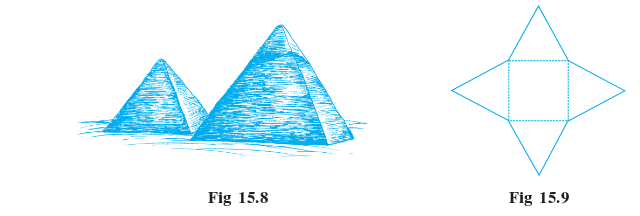
Try These
Here you find four nets (Fig 15.10). There are two correct nets among them to make a tetrahedron. See if you can work out which nets will make a tetrahedron.
two correct nets among them to make a tetrahedron. See if you can work out which nets will make a tetrahedron.

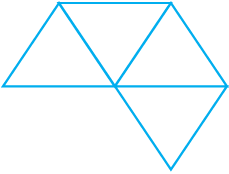
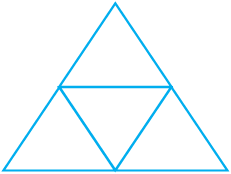

Fig 15.10
Exercise 15.1
1. Identify the nets which can be used to make cubes (cut out copies of the nets and try it):

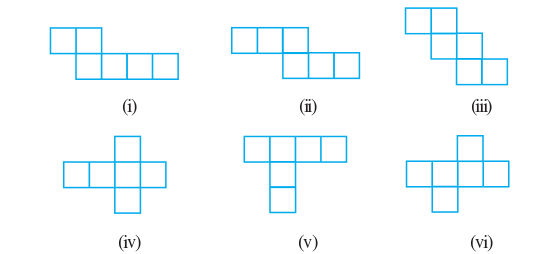
2. Dice are cubes with dots on each face. Opposite faces of a die always have a total of

seven dots on them.
Here are two nets to make dice (cubes); the numbers inserted in each square indicate the number of dots in that box.
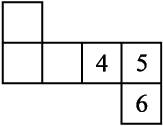
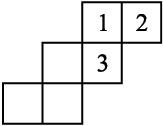
Insert suitable numbers in the blanks, remembering that the number on the opposite faces should total to 7.
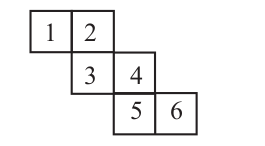
Explain your answer.
4. Here is an incomplete net for making a cube. Complete it in at least two different ways. Remember that a cube has six faces. How many are there in the net here? (Give two separate diagrams. If you like, you may use a squared sheet for easy manipulation.) 
5. Match the nets with appropriate solids:
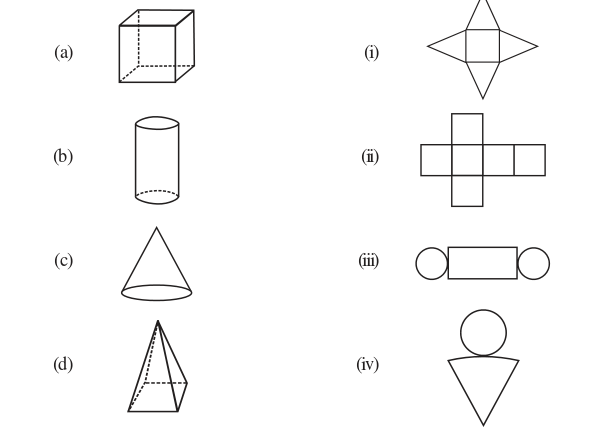
Play this game
You and your friend sit back-to-back. One of you reads out a net to make a 3-D shape, while the other attempts to copy it and sketch or build the described 3-D object.
15.4 Drawing Solids on a Flat Surface
Your drawing surface is paper, which is flat. When you draw a solid shape, the images are somewhat distorted to make them appear three-dimensional. It is a visual illusion. You will find here two techniques to help you.
15.4.1 Oblique Sketches

Fig 15.11
Here is a picture of a cube (Fig 15.11). It gives a clear idea of how the cube looks like, when seen from the front. You do not see certain faces. In the drawn picture, the lengths are not equal, as they should be in a cube. Still, you are able to recognise it as a cube. Such a sketch of a solid is called an oblique sketch.
How can you draw such sketches? Let us attempt to learn the technique.
You need a squared (lines or dots) paper. Initially practising to draw on these sheets will later make it easy to sketch them on a plain sheet (without the aid of squared lines or dots!) Let us attempt to draw an oblique sketch of a 3 × 3 × 3 (each edge is 3 units) cube (Fig 15.12).
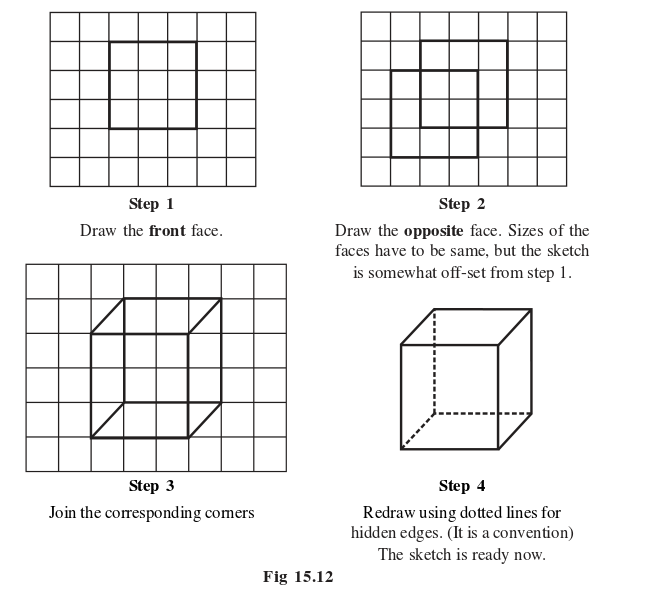
(i) The sizes of the front faces and its opposite are same; and
(ii) The edges, which are all equal in a cube, appear so in the sketch, though the actual measures of edges are not taken so.
You could now try to make an oblique sketch of a cuboid (remember the faces in this case are rectangles)
Note: You can draw sketches in which measurements also agree with those of a given solid. To do this we need what is known as an isometric sheet. Let us try to make a cuboid with dimensions 4 cm length, 3 cm breadth and 3 cm height on given isometric sheet.
15.4.2 Isometric Sketches
Have you seen an isometric dot sheet? (A sample is given at the end of the book). Such a sheet divides the paper into small equilateral triangles made up of dots or lines. To draw sketches in which measurements also agree with those of the solid, we can use isometric dot sheets. [Given on inside of the back cover (3rd cover page).]
Let us attempt to draw an isometric sketch of a cuboid of dimensions 4 × 3 × 3 (which means the edges forming length, breadth and height are 4, 3, 3 units respectively) (Fig 15.13).
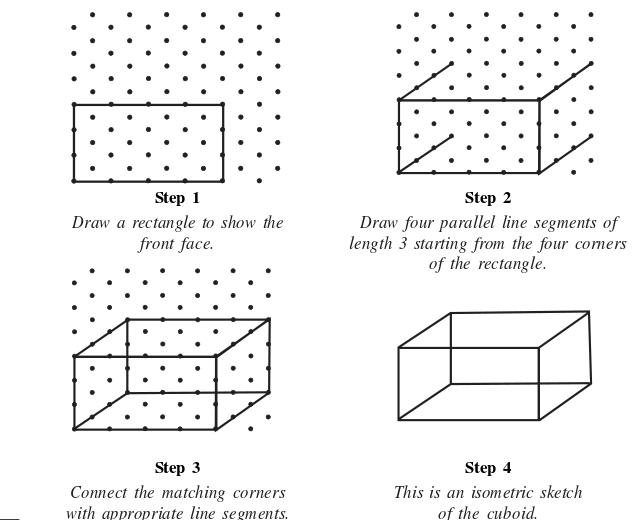
Note that the measurements are of exact size in an isometric sketch; this is not so in the case of an oblique sketch.
Example 1
Here is an oblique sketch of a cuboid [Fig 15.14(i)]. Draw an isometric sketch that matches this drawing.
Fig 15.14 (i)
Solution:
Here is the solution [Fig 15014(ii)]. Note how the measurements are taken care of.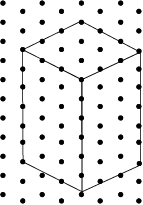
Fig 15.14(ii)
How many units have you taken along (i) ‘length’? (ii) ‘breadth’? (iii) ‘height’? Do they match with the units mentioned in the oblique sketch?
Exercise 15.2

1. Use isometric dot paper and make an isometric sketch for each one of the given shapes:
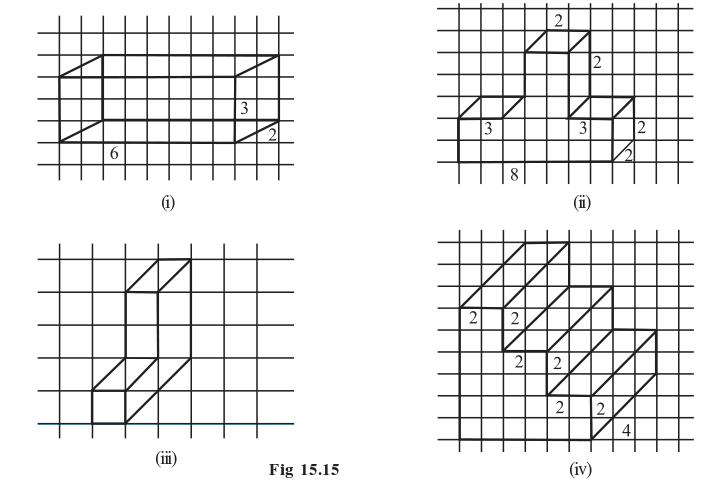
3. Three cubes each with 2 cm edge are placed side by side to form a cuboid. Sketch an oblique or isometric sketch of this cuboid.
4. Make an oblique sketch for each one of the given isometric shapes:
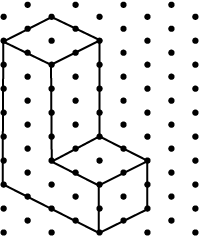

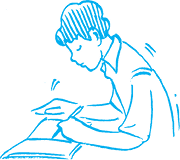
5. Give (i) an oblique sketch and (ii) an isometric sketch for each of the following:
(a) A cuboid of dimensions 5 cm, 3 cm and 2 cm. (Is your sketch unique?)
(b) A cube with an edge 4 cm long.
An isometric sheet is attached at the end of the book. You could try to make on it some cubes or cuboids of dimensions specified by your friend.
15.4.3 Visualising Solid Objects
Do This

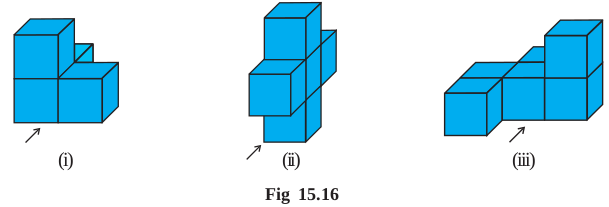
Now ask your friend to guess how many cubes there are when observed from the view shown by the arrow mark.
Try These

Such visualisation is very helpful. Suppose you form a cuboid by joining such cubes. You will be able to guess what the length, breadth and height of the cuboid would be.
Example 2
If two cubes of dimensions 2 cm by 2cm by 2cm are placed side by side, what would the dimensions of the resulting cuboid be?
As you can see (Fig 15.18) when kept side by side, the length is the only measurement which increases, it becomes 2+2=4 cm.
The breadth = 2 cm and the height = 2 cm.
Try These
(a) 5 + 6 (b) 4 + 3

(Remember that in a die sum of numbers on opposite faces is 7)
2. Three cubes each with 2 cm edge are placed side by side to form a cuboid. Try to make an oblique sketch and say what could be its length, breadth and height.
15.5 Viewing Different Sections of a Solid
Now let us see how an object which is in 3-D can be viewed in different ways.
15.5.1 One Way to view an Object is by Cutting or Slicing
Slicing game
Here is a loaf of bread (Fig 15.20). It is like a cuboid with a square face. You ‘slice’ it with a knife.
‘cross-section’ of the whole bread. The cross section is nearly a square in this case.

Fig 15.20
Beware! If your cut is not ‘vertical’ you may get a different cross section! Think about it. The boundary of the cross-section you obtain is a plane curve. Do you notice it?
A kitchen play
Have you noticed cross-sections of some vegetables when they are cut for the purposes of cooking in the kitchen? Observe the various slices and get aware of the shapes that result as cross-sections.
Play this
Make clay (or plasticine) models of the following solids and make vertical or horizontal cuts. Draw rough sketches of the cross-sections you obtain. Name them wherever you can.


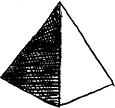


Fig 15.21
Exercise 15.3
1. What cross-sections do you get when you give a
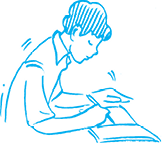 (i) vertical cut (ii) horizontal cut
(i) vertical cut (ii) horizontal cut
to the following solids?
(a) A brick (b) A round apple (c) A die
(d) A circular pipe (e) An ice cream cone
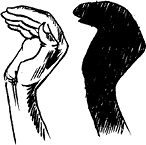
15.5.2 Another Way is by Shadow Play
A shadow play
Shadows are a good way to illustrate how three-dimensional objects can be viewed in two dimensions. Have you seen a shadow play? It is a form of entertainment using solid articulated figures in front of an illuminated back-drop to create the illusion of moving images. It makes some indirect use of ideas in Mathematics.

Fig 15.23
You will need a source of light and a few solid shapes for this activity. (If you have an overhead projector, place the solid under the lamp and do these investigations.)
Keep a torchlight, right in front of a Cone. What type of shadow does it cast on the screen? (Fig 15.23)
The solid is three-dimensional; what is the dimension of the shadow?
If, instead of a cone, you place a cube in the above game, what type of shadow will you get?
Experiment with different positions of the source of light and with different positions of the solid object. Study their effects on the shapes and sizes of the shadows you get.
Here is another funny experiment that you might have tried already: Place a circular plate in the open when the Sun at the noon time is just right above it as shown in Fig 15.24 (i).

What is the shadow that you obtain?
Will it be same during
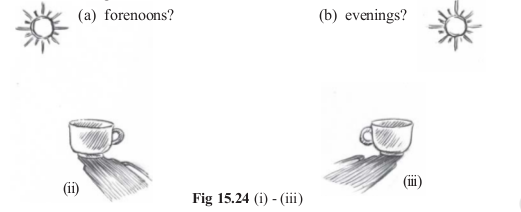
Study the shadows in relation to the position of the Sun and the time of observation.
Exercise 15.4

1. A bulb is kept burning just right above the following solids. Name the shape of the shadows obtained in each case. Attempt to give a rough sketch of the shadow. (You may try to experiment first and then answer these questions)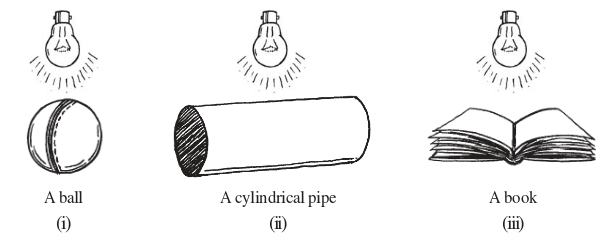
A circle A square A triangle A rectangle
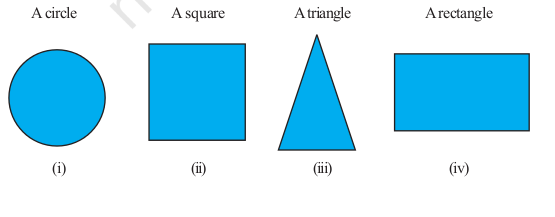
(i) The cube can cast a shadow in the shape of a rectangle.
(ii) The cube can cast a shadow in the shape of a hexagon.
15.5.3 A Third Way is by Looking at it from Certain Angles to Get Different Views
One can look at an object standing in front of it or by the side of it or from above. Each time one will get a different view (Fig 15.25).
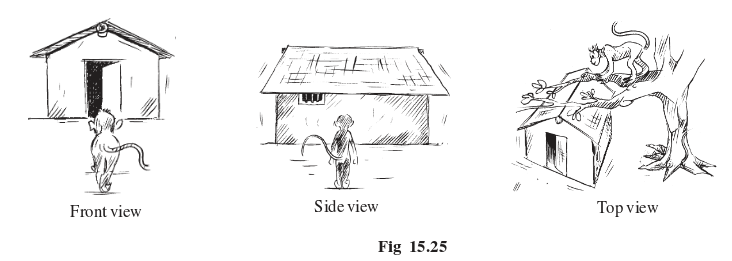
Building Front view Side view Top view

Fig 15.26
You could do this for figures made by joining cubes.

Fig 15.27
Try putting cubes together and then making such sketches from different sides.
Try These
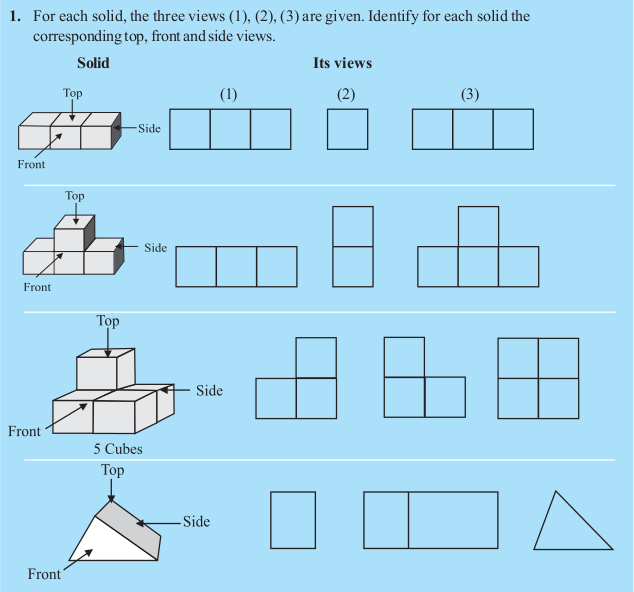

What have We Discussed?
2. Plane figures are of two-dimensions (2-D) and the solid shapes are of three-dimensions (3-D).
3. The corners of a solid shape are called its vertices; the line segments of its skeleton are its edges; and its flat surfaces are its faces.
4. A net is a skeleton-outline of a solid that can be folded to make it. The same solid can have several types of nets.
5. Solid shapes can be drawn on a flat surface (like paper) realistically. We call this
2-D representation of a 3-D solid.
6. Two types of sketches of a solid are possible:
(a) An oblique sketch does not have proportional lengths. Still it conveys all important aspects of the appearance of the solid.
(b) An isometric sketch is drawn on an isometric dot paper, a sample of which is given at the end of this book. In an isometric sketch of the solid the measurements kept proportional.
7. Visualising solid shapes is a very useful skill. You should be able to see ‘hidden’ parts of the solid shape.
8. Different sections of a solid can be viewed in many ways:
(a) One way is to view by cutting or slicing the shape, which would result in the cross-section of the solid.
(b) Another way is by observing a 2-D shadow of a 3-D shape.
(c) A third way is to look at the shape from different angles; the front-view, the side-view and the top-view can provide a lot of information about the shape observed.
